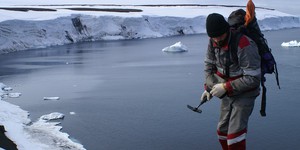Abstract
For many kids, a day at the beach would not be complete without building a sandcastle. Have you ever wondered how it is that you can pack sand into a mold for a sandcastle? Do some kinds of sand pack better than others? This project will show you how to measure the porosity of sand: how much air space there is in between the sand grains. Maybe you can use your knowledge from this project to help you make bigger and better projects with sand.Summary
Andrew Olson, Ph.D., Science Buddies
Objective
The goal of this project is to measure the density and porosity of various samples of sand.
Introduction
If you've ever made sandcastles at the beach, you know that you need to press hard and pack the sand tightly inside your bucket if you want it to hold its shape when you turn the bucket over to make a tower. Did you ever stop and think how it is that you can make the sand take up less space?
Sand is made up of tiny individual grains. The grains come from rock-and sometimes from other materials, such as coral or other marine organisms with calcareous body parts. These materials have been eroded over time by natural forces like wind, ice, and moving water. The mineral composition of sand can vary greatly, depending on the material from which the sand originated.
The individual grains come in many different sizes. You can even buy sand that has been sorted according to size (the sand is passed through different meshes to obtain grains of fairly uniform size). When sand grains are piled on top of one another, the grains don't fit perfectly together. There are voids (empty spaces) in between the grains. The volume of these voids in a sample of sand is sometimes referred to as the porosity of the sand.
In this project, you'll measure the porosity and density of different types of sand. Do smaller grains pack together more tightly so that the sand is less porous? Or is the amount of air space the same (or even greater) in fine-grained sand because there are more grains (thus more air pockets) in the same space? What do you think? We'll show you how to make the measurements to find out for yourself.
Terms and Concepts
To do this project, you should do research that enables you to understand the following terms and concepts:
- Mass
- Volume
- Density
- Air space
- Percent porosity
- Sand structure
Questions
- How does air space change as the grain size of the sand varies?
Bibliography
- Here's some good background information on the structure of sand:
Armstrong, W.P., 2006. Sand Grains: Chips Off the Old Rock, Wayne's Word, An Online Textbook of Natural History. Retrieved June 25, 2007. - Astronauts bringing sand into space? Here is a cool article from NASA on the properties of sand under pressure:
Barry, P.L., 2002. The Physics of Sandcastles, National Aeronautics and Space Administration. Retrieved June 20, 2007. - Here is an Excel tutorial to get you started using a spreadsheet program:
Excel Easy. (n.d.). Excel Easy: #1 Excel tutorial on the net. Retrieved July 15, 2014.
Materials and Equipment
To do this experiment you will need the following materials and equipment:
- Several different samples of dry sand with different grain sizes
- Funnel
- 10 mL graduated cylinder; available from Amazon.com
- 50 mL graduated cylinder; available from Amazon.com
- Stirring rod (to fit 50 mL cylinder)
- Kitchen balance (preferably with gram scale), such as the Fast Weigh MS-500-BLK Digital Pocket Scale, 500 by 0.1 G, available from Amazon.com
- Water
- Calculator or spreadsheet program (e.g., Microsoft Excel or WordPerfect QuattroPro)
Disclaimer: Science Buddies participates in affiliate programs with Home Science Tools, Amazon.com, Carolina Biological, and Jameco Electronics. Proceeds from the affiliate programs help support Science Buddies, a 501(c)(3) public charity, and keep our resources free for everyone. Our top priority is student learning. If you have any comments (positive or negative) related to purchases you've made for science projects from recommendations on our site, please let us know. Write to us at scibuddy@sciencebuddies.org.
Experimental Procedure
- Do your background research so that you are familiar with the terms, concepts, and questions, above.
- Weigh the empty graduated cylinder on the kitchen scale. Record the mass of the cylinder (in g) in your lab notebook.
- Use the funnel to pour a sample of dry sand into the graduated cylinder. You want it to be about half-way full (5-6 mL), but the exact amount is not critical.
- Read the actual volume of sand using the markings on the graduated cylinder. Record the measured volume in your lab notebook.
- Again weigh the cylinder (now with the sand sample inside) and record the mass.
- Subtract the weight of the empty cylinder to get the mass of the sand sample itself.
- Pour the soil sample from the 10 mL graduated cylinder into the 50 mL graduated cylinder.
- Measure out 7-8 mL of water in the 10 mL graduated cylinder. Record the exact amount in your lab notebook.
- Add the water to the 50 mL graduated cylinder with the sand. Stir the mixture so that the water can completely penetrate the sand.
- Measure and record the total volume of the sand/water mixture.
- Clean and dry both graduated cylinders, and repeat steps 2-9 three times for each type of sand you are testing (do at least four trials per type of sand).
Analyze Your Data
- You can organize your data in a table like the one below:
Volume of sand
(mL)Mass of cylinder + sand
(g)Mass of cylinder alone
(g)Mass of sand alone
(g)Density of sand
(g/mL)Volume of water
(mL)Volume of sand + water
(mL)Air space volume
(mL)Fractional air space
(%)
- As you can see, some of the columns contain measured data, and others are from calculations that you perform on the measured data.
- Calculate the mass of the sand alone. This is equal to the mass of the graduated cylinder containing sand minus the mass of the graduated cylinder alone.
- Calculate the density of the sand. Remember that density is the mass per unit volume. Divide the mass of the sand by the volume of the sand.
- Calculate the air space volume. It will be equal to the volume of the sand alone plus the volume of the water alone minus the volume of the sand/water mixture.
- Calculate the fractional air space. Another way to measure the air space is as a percentage of the total volume of the sand. Here's how to calculate the fractional air space:
- Divide the air space volume (in mL) by the starting volume of sand (also in mL).
- Multiply the resulting fraction by 100.
- The result is the percentage of the original volume of sand that is occupied by air in between the grains.
- Note: more advanced students can use a spreadsheet program to perform the data analysis calculations. There is a tutorial on programming calculations with a spreadsheet listed in the Bibliography (James, date unknown).
- How does air space change as the grain size of the sand varies?
Ask an Expert
Global Connections
The United Nations Sustainable Development Goals (UNSDGs) are a blueprint to achieve a better and more sustainable future for all.
Variations
- Soil can become compacted over time by pressure from above. Try compacting the samples of sand and comparing the density and porosity measurements with uncompacted samples. Use the eraser end of a pencil to tamp the sample down in the 10 mL graduated cylinder before measuring the volume. Now comes the tricky part: Can you figure out a way to get water to permeate the sample without stirring it? Stirring would "un-pack" the sand, so you'll need to come up with a good way to get water into the sample without disturbing the sand by stirring. How does pencil-tamping affect the density of the sand sample? How does pencil-tamping affect the porosity of the sand sample?
- For a related experiment that examines how the volume of sand changes under pressure, see the Science Buddies project Beach Bum Science: Compression of Wet Sand.
Careers
If you like this project, you might enjoy exploring these related careers:










